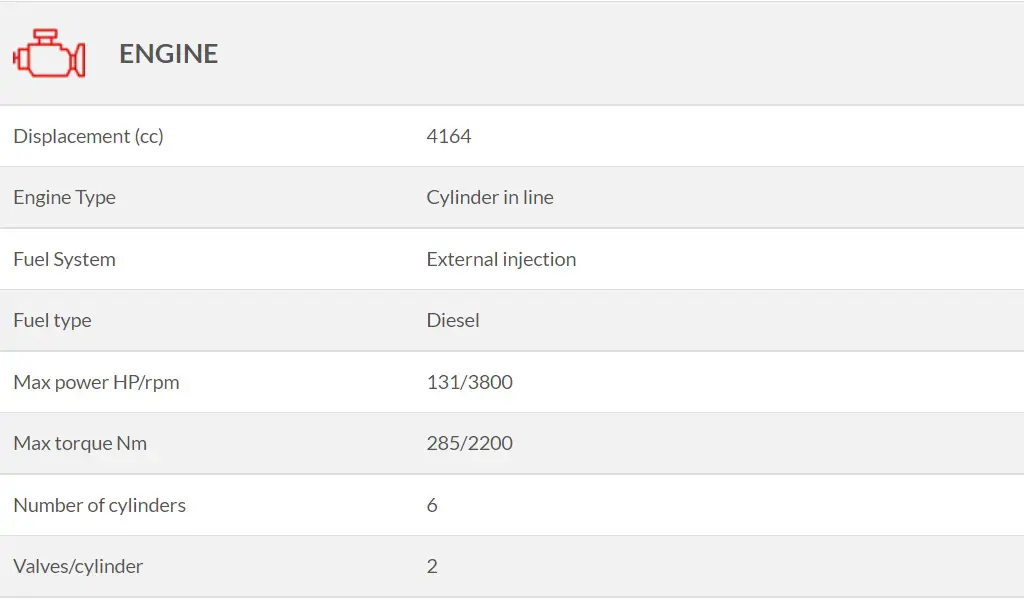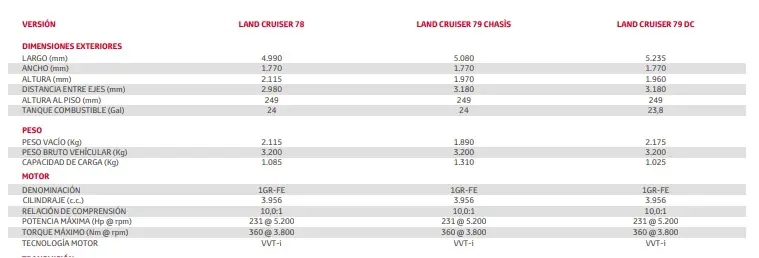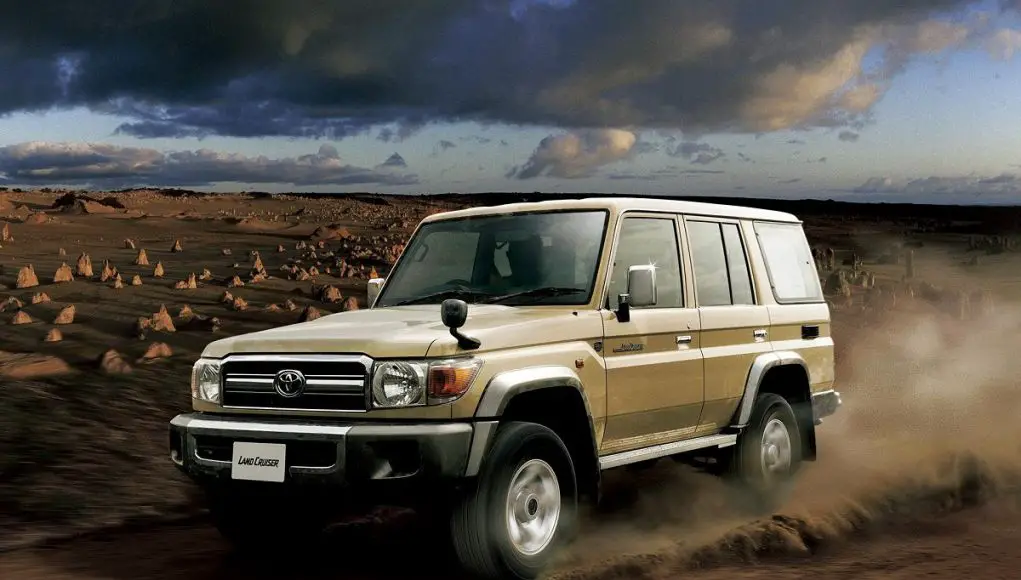2024 is the 40th anniversary of Toyota selling the 70-series Land Cruiser. But, will it ever die?
It comes as a surprise for even the most informed car enthusiasts, except those in the know, when I tell them that Toyota still sells a car they first introduced in 1984.
Embed from Getty ImagesYes, it’s true, take a look at Toyota’s homepage in a country outside of the United States, like Toyota of Zimbabwe or Nicaragua, and you’ll see they still sell the old 70-series Land Cruiser, often in more than one configuration.
Taking a quick look at what you get and, from an outside perspective, people are paying top dollar (they start out at $39,000 in NI) for what amounts to a very basic truck.
Keep in mind, the average Nicaraguan only makes $400 USD/month.
We’re talking about a simple five-speed manual, no power windows, no power mirrors, no radio (you can forget about your Apple carplay or Android Auto,) old school 16′ steel wheels, no ABS, and the front passenger doesn’t even get an airbag.

How can Toyota get away with this?
Are they charging way too much, price gouging the local people?
The answer is Toyota largely sells Land Cruisers in so-called developing, second, third-world, and up-and coming countries that still have large expanses of undeveloped roads because there’s still demand for a no-frills truck they can depend on.
That means mainly a bulletproof engine and transmission, a simple yet capable suspension, and a supportive factory and aftermarket scene.
No one does that better than Toyota.
For example, do yourself a favor and click around Google Maps to see what kind of roads surround Nicaragua, the main roads are still mostly dirt.
And, check out this road in Zimbabwe, a photo that inspired this blog post. Most of the popular crossovers sold in the United States would not survive a trip to the grocery store on those roads.
Never complain about the state of your roads again. pic.twitter.com/UJXuxOEmlR
— Snugbucket (@Snugbucket) June 7, 2022
A reliable engine, most with a diesel from the ’90s
Click on the engine specs of these new 70-series LCs and, in countries that still offers diesel, this is what you’ll see, a 4.2L engine.

What these specs won’t tell you is this is a 1HZ-FE Diesel, a straight six engine first introduced in 1990.
Unlike diesels in the United States, it isn’t turbocharged, it’s naturally aspirated.
With only 130 HP (but a decent amount of torque) it’s a slug to drive.
Regardless, it’s a classic workhorse engine that’s durable and will run everyday all day.
In a country with poor roads and possibly days of travel between a competent mechanic, there’s really few engine options that do it as well as an N.A. Diesel engineered by Toyota.
And, in countries, like Colombia and Australia where gasoline engines are preferred (or required) over diesel, Toyota offers robust engine choices, too, the most common being these over-engineered 1GR-FEs V6s.
First introduced in 2002, LCs still use these water-cooled, naturally aspirated engines.

Solid beam axle suspensions front and back
Unlike modern crossovers and SUVs that have independent suspension at all four corners, 70-series LCs still uses a rigid axle with coil springs up front and rigid axles with leaf springs out back.
A rigid axle means, according to The Engine Block,
“…both wheels will be connected to a single axle housing that runs the span of the vehicle. This solid axle that is physically connecting both wheels to the same housing, is what makes the suspension dependent. This means that regardless of the exact suspension type, one wheel moving up or down will directly impact the wheel on the other side.”
The main advantages of this kind of suspension is it’s a lot more simple compared to an independent suspension, can handle heavier loads, and, is overall more cheaper to maintain.
Most importantly, the two main advantages of having a rigid axle up front are, according to Car and Bike Tech,
- “Prevents the vehicle body from tipping while traveling over rough ground or when turning. This helps to minimize the tendency of rolling, pitching, or vertical movement.”
- “Maintains the vehicle body at perfect level while traveling over rough, uneven ground. This enables the up and down movement of the wheels relative to the body.”
When you’re buying reliable transport in a country that doesn’t have paved roads, these two points are important.
Only two cars sold in the United States still hase a solid axle front suspension, the Jeep Wrangler and Mercedes G-Class.
Even the newest Land Cruisers no longer have rigid axles up front.
Toyota’s factory support and a multi-year aftermarket presence
While these old Land Cruisers are generally reliable as the rising sun, it’s not like they don’t break down or ever need repairs.
Life, and mistakes…happen.
Invariably, when you buy a car, buying one with some kind of OEM or aftermarket support is a good idea.
Your car can soon become an expensive paperweight if you can’t find parts for it.
Since the 70-series Land Cruiser has been around for so long, not only is Toyota still making parts for it (case in point Toyota of Zimbabwe still makes Ball Joints for these LCs,) since the 70-series is ’80s and ’90s technology, they’re still repairable.
If you can’t work on it yourself, chances are good you can find someone locally who can.
For Toyota, it’s a moneymaker
According to some estimates, developing a new vehicle costs automakers upwards of $1B.
Although Toyota throws refreshes and tweaks at the 70-series LC, Toyota’s already largely paid for the R&D costs to develop this truck.
And, it’s safe to say the 70-series has paid for itself several times over.
If Toyota is in the business of making a profit (doing what’s in the best interest of its shareholders,) it would stand to reason to continue making 70-series Land Cruisers as long as customers still want them.
As of this writing, it’s still so in demand, Toyota’s got a two-year waiting list for a new one.
Conclusion
Despite all the talk in the United States of going electric in a car-buying atmosphere where we expect cars to be updated every year, it’s not the same car climate in many parts of the world.
There is still a market for new, honest-to-goodness, regular ol’ trucks that run on diesel (or gas) and are expected to run sun up to sundown without skipping a beat.
That reputation and the level of engineering to achieve that isn’t something that happens overnight, it’s comes from making a product right the first time, over-engineering it so it outlasts its owner(it’s true,) and providing support for it for years to come.
Sure, you can update it but, (It’s cliché, I know) if it ain’t broke, why fix it?
And that’s why Toyota will still sell the 70-series Land Cruiser in many markets for the foreseeable future.



